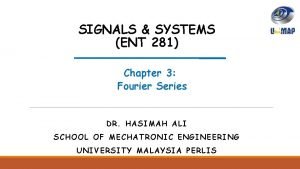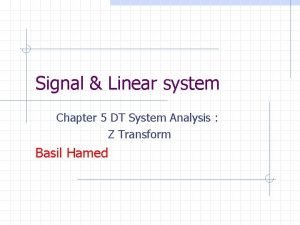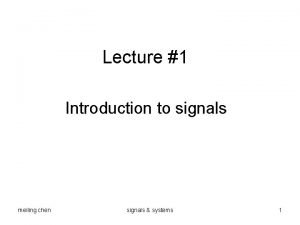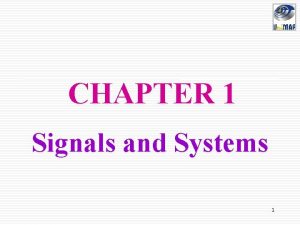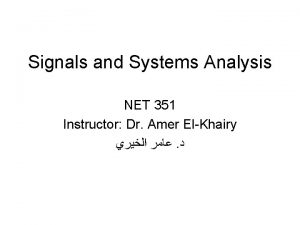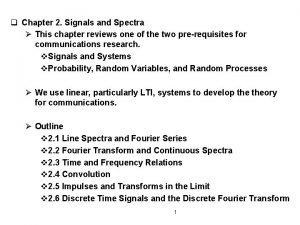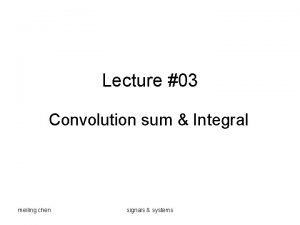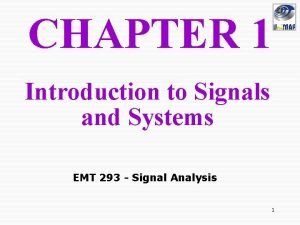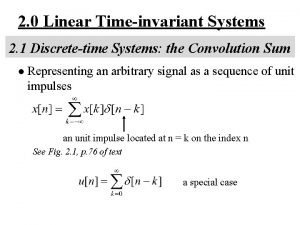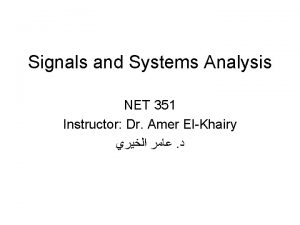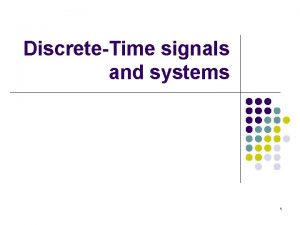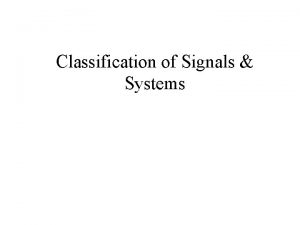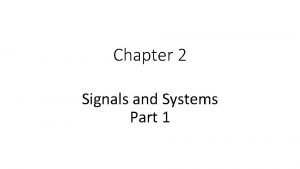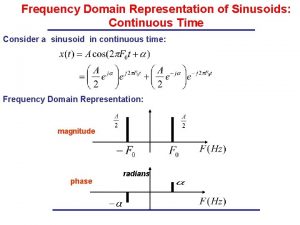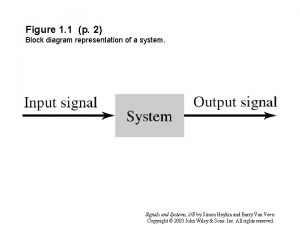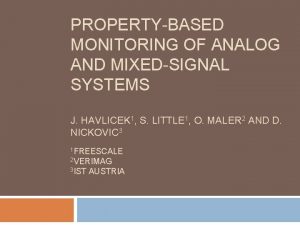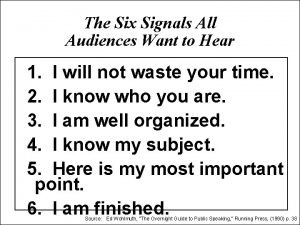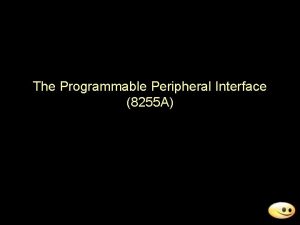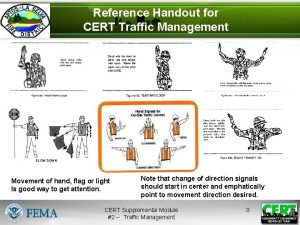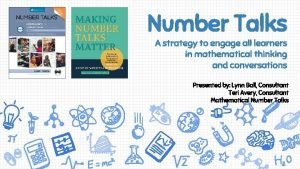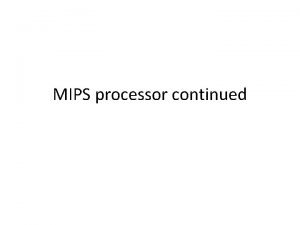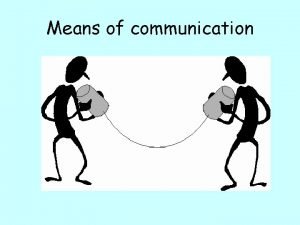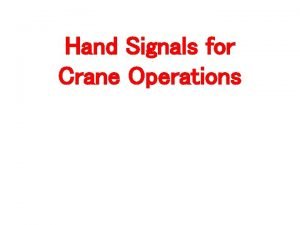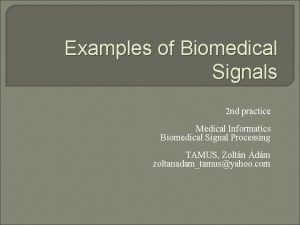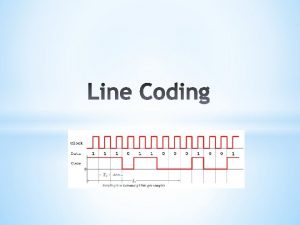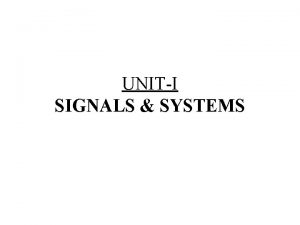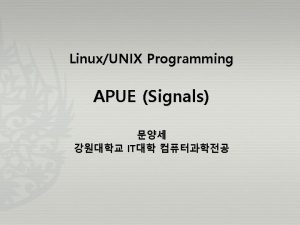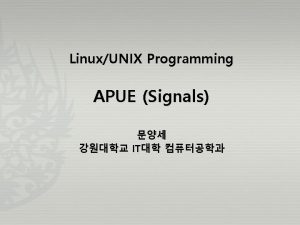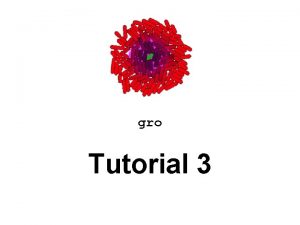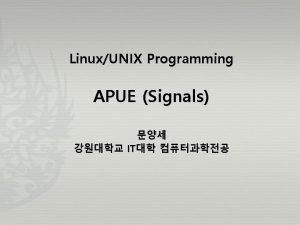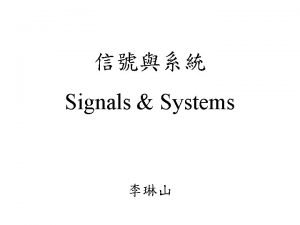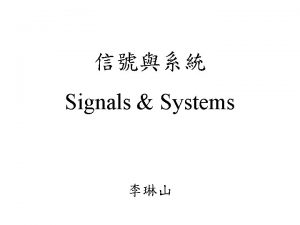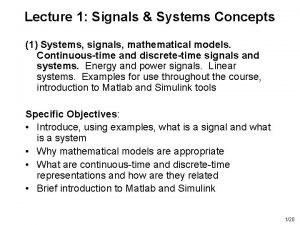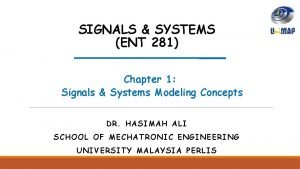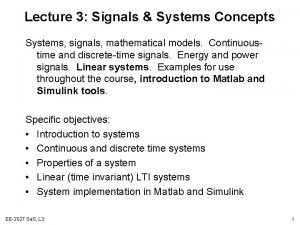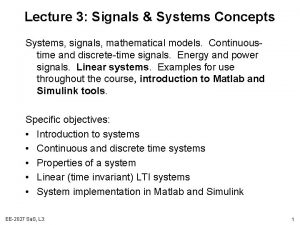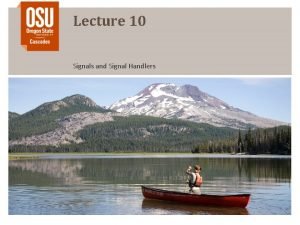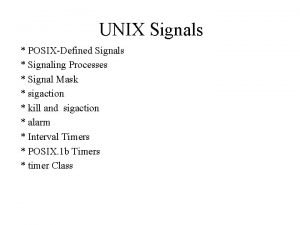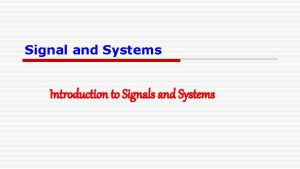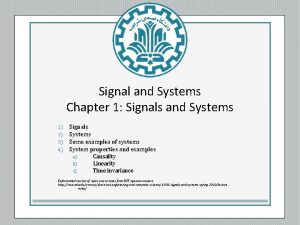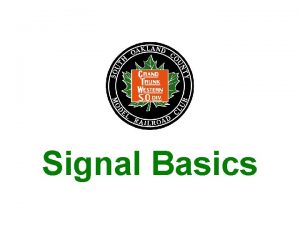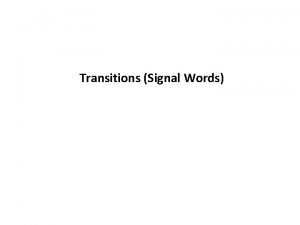Signals Systems A Signal l A signal is




















![1. 0 Fundamentals 1. 1 Signals Continuous/Discrete-time Signals x(t), x[n] Signal Energy/Power 1. 0 Fundamentals 1. 1 Signals Continuous/Discrete-time Signals x(t), x[n] Signal Energy/Power](https://slidetodoc.com/presentation_image_h2/92ee39539a06f8b3c35b0da7204338da/image-21.jpg)
![Continuous/Discrete-time x[n ] x(t) t n Continuous/Discrete-time x[n ] x(t) t n](https://slidetodoc.com/presentation_image_h2/92ee39539a06f8b3c35b0da7204338da/image-22.jpg)

![Time Scaling x[n ] x(t) ? x(at), a<1 ? x(at), a>1 Time Scaling x[n ] x(t) ? x(at), a<1 ? x(at), a>1](https://slidetodoc.com/presentation_image_h2/92ee39539a06f8b3c35b0da7204338da/image-24.jpg)





















![Unit Impulse & Unit Step l Discrete-time δ [n] n u [n – 1] Unit Impulse & Unit Step l Discrete-time δ [n] n u [n – 1]](https://slidetodoc.com/presentation_image_h2/92ee39539a06f8b3c35b0da7204338da/image-46.jpg)


![1. 2 Systems l Continuous/Discrete-time Systems x(t) l y(t) x[n] Interconnections of Systems – 1. 2 Systems l Continuous/Discrete-time Systems x(t) l y(t) x[n] Interconnections of Systems –](https://slidetodoc.com/presentation_image_h2/92ee39539a06f8b3c35b0da7204338da/image-49.jpg)










- Slides: 59

信號與系統 Signals & Systems 李琳山

A Signal l A signal is a function of one or more variables, which conveys information on the nature of some physical phenomena. l Examples –f(t) : a voice signal, a music signal –f(x, y) : an image signal, a picture – f ( x , y , t ) : a video signal – xn : a sequence of data ( n: integer ) – bn : a bit stream ( b: 1 or 0 ) – continuous-time, discrete-time – analog, digital l Human Perceptible/Machine Processed

A Signal

A System l An entity that manipulates one or more signals to accomplish some function, including yielding some new signals. input signal l System output signal Examples – an electric circuit – a telephone handset – a PC software receiving pictures from Internet – a TV set – a computer with some software handling some data

Typical Examples of Signals/Systems Concerned l Communication Systems Transmitter Message signal (information ) data, text, audio, video s(t ) r(t) Channel Transmitted signal noise, loss distortion, interference Receiver Received signal Estimate of message signal (information)

Typical Examples of Signals/Systems Concerned l Computers l Signal Processing Systems – software systems processing the signal by computation/ memory – examples : audio enhancement systems, picture processing systems, video compression systems, voice recognition/ synthesis systems, array signal processors, equalizers, etc.

Audio Enhancement Picture Processing

Typical Examples of Signals/Systems Concerned l Networks user B user A

Typical Examples of Signals/Systems Concerned l Information Retrieval Systems Internet l Other Information Systems Search Engine User – examples : remote sensing systems, biomedical signal processing systems, etc.

Internet Digital Libraries, Virtual Museums, . . . Google, Facebook, You. Tube, Amazon. . . Electronic Commerce, Network Banking, . . . Electronic Government Services, . . . Intelligent Offices, Distant Learning, . . . Electronic Home, Network Entertainment. . .

Internet l Network Technology Connects Everywhere Globally l Huge Volume of Information Disseminated across the Globe in Microseconds l Multi-media, Multi-lingual, Multi-functionality l Cross-cultures, Cross-domains, Cross-regions l Integrating All Knowledge Systems and Information related Activities Globally

Typical Examples of Signals/Systems Concerned l Control Systems – close-loop/feedback control systems input signal x(t) error signal e(t) control signal v(t) controller feedback signal plant disturbance z(t) output signal y(t) sensor – example: aircraft landing systems, satellite stabilization systems, robot arm control systems, etc.

Typical Examples of Signals/Systems Concerned l Other Systems – manufacturing systems, computer-aided-design systems, mechanical systems, chemical process systems, etc.

Scope of The Course l Those Signals/Systems Operated by Electricity, in Particular by Software and Computers, with Extensive Computation and Memory, for Information and Control Primarily l Analytical Framework to Handle Such Signals/Systems l Mathematical Description/Representation of Such Signals/Systems

Scope of The Course l Language and Tools to Solve Problems with Such Signals/Systems l Closely Related to: Communications, Signal Processing, Computers, Networks, Control, Biomedical Engineering, Circuits, Chips, EM Waves, etc. l A Fundamental Course for E. E.

Text/Reference Books and Lecture Notes l Textbook: – Oppenheim & Willsky, “Signals & Systems”, 2 nd Ed. 1997 – Prentice-Hall, 新月 l Reference: – S. Haykin & B. Van Veen, “Signals & Systems”, 1999 – John Willey & Sons, 歐亞 l Lecture Notes: – Available on web before the day of class

Course Outline 1. 2. 3. 4. 5. Fundamentals Linear Time-invariant Systems Fourier Series & Fourier Transform Discrete Fourier Transform (DFT) Time/Frequency Characterization of Signals/Systems 6. Sampling & Sampling Theorem 7. Communication Systems 8. Laplace Transform 9. Z-Transform 10. Linear Feedback Systems 11. Some Application Examples

History of the Area l Independently Developed by People Working on Different Problems in Different Areas l Fast Development after Computers Become Available and Powerful l Re-organized into an Integrated Framework

Background Required l 2 nd semester of 2 nd year of EE l Mathematics l Pre-requisite : No Grading l Midterm 35% l Final 35% l MATLAB Problems 20% l Homeworks 10%

![1 0 Fundamentals 1 1 Signals ContinuousDiscretetime Signals xt xn Signal EnergyPower 1. 0 Fundamentals 1. 1 Signals Continuous/Discrete-time Signals x(t), x[n] Signal Energy/Power](https://slidetodoc.com/presentation_image_h2/92ee39539a06f8b3c35b0da7204338da/image-21.jpg)
1. 0 Fundamentals 1. 1 Signals Continuous/Discrete-time Signals x(t), x[n] Signal Energy/Power
![ContinuousDiscretetime xn xt t n Continuous/Discrete-time x[n ] x(t) t n](https://slidetodoc.com/presentation_image_h2/92ee39539a06f8b3c35b0da7204338da/image-22.jpg)
Continuous/Discrete-time x[n ] x(t) t n

Transformation of A Signal l Time Shift l Time Reversal l Time Scaling l Combination
![Time Scaling xn xt xat a1 xat a1 Time Scaling x[n ] x(t) ? x(at), a<1 ? x(at), a>1](https://slidetodoc.com/presentation_image_h2/92ee39539a06f8b3c35b0da7204338da/image-24.jpg)
Time Scaling x[n ] x(t) ? x(at), a<1 ? x(at), a>1

Periodic Signal T 0 : Fundamental period : the smallest positive value of T aperiodic : NOT periodic

Even/Odd Signals l Even l Odd l Any signal can be discomposed into a sum of an even and an odd

Even/Odd Even x(-t)=x(t) Odd x(-t)=-x(t)

Exponential/Sinusoidal Signals l Basic Building Blocks from which one can construct many different signals and define frameworks for analyzing many different signals efficiently fundamental period fundamental frequency

Exponential/Sinusoidal Signals

Vector Space 3 -dim Vector Space

N-dim Vector Space (合成) (分析 )

Signal Analysis

Exponential/Sinusoidal Signals l Harmonically related signal sets fundamental period fundamental frequency all with common period

Exponential/Sinusoidal Signals l Sinusoidal signal l General format l Discrete-Time

Exponential/Sinusoidal Signals l Important Differences Between Continuous-time and Discrete-time Exponential/Sinusoidal Signals – For discrete-time, signals with frequencies ω0 and ω0 +m.2π are identical. This is Not true for continuous-time. see : Fig. 1. 27, p. 27 of text

Continuous/Discrete Sinusoidals 0 1 2 3 4 5


Fig. 1. 27 but Note:

Exponential/Sinusoidal Signals l Important Differences Between Continuous-time and Discrete-time Exponential/Sinusoidal Signals – For discrete-time, ω0 is usually defined only for [-π, π] or [0, 2π]. For continuous-time, ω0 is defined for (-∞, ∞) – For discrete-time, the signal is periodic only when ω0 N=2πm, see : Fig. 1. 25, p. 24 of text


Harmonically Related Signal Sets For being periodic real period in cycles real period in n divided in N

Exponential/Sinusoidal Signals l Harmonically related discrete-time signal sets all with common period N This is different from continuous case. Only N distinct signals in this set.

Unit Impulse and Unit Step Functions l Continuous-time – First Derivative see: Fig 1. 33, Fig 1. 34, P, 33 of text – Running Integral – Sampling property


Unit Impulse and Unit Step Functions l Discrete-time – First difference – Running Sum – Sampling property
![Unit Impulse Unit Step l Discretetime δ n n u n 1 Unit Impulse & Unit Step l Discrete-time δ [n] n u [n – 1]](https://slidetodoc.com/presentation_image_h2/92ee39539a06f8b3c35b0da7204338da/image-46.jpg)
Unit Impulse & Unit Step l Discrete-time δ [n] n u [n – 1] n δ [n] = u[n] – u[n – 1]

Vector Space Representation of Discretetime Signals l n-dim

![1 2 Systems l ContinuousDiscretetime Systems xt l yt xn Interconnections of Systems 1. 2 Systems l Continuous/Discrete-time Systems x(t) l y(t) x[n] Interconnections of Systems –](https://slidetodoc.com/presentation_image_h2/92ee39539a06f8b3c35b0da7204338da/image-49.jpg)
1. 2 Systems l Continuous/Discrete-time Systems x(t) l y(t) x[n] Interconnections of Systems – Series – Parallel + y[n]

l Interconnections of Systems – Feedback + – Combinations

l Stability – stable : bounded inputs lead to bounded outputs l Time Invariance – time invariant : behavior and characteristic of the system are fixed over time

Stability Examples of unstable systems Amp Time Invariance x(t) x(t-T 0) y(t-T 0)

l Linearity – linear : superposition property – scaling or homogeneity property – additive property

l Memoryless/With Memory – Memoryless : output at a given time depends only on the input at the same time eg. – With Memory eg.

l Invertibility – invertible : distinct inputs lead to distinct outputs, i. e. an inverse system exits eg. l Causality – causal : output at any time depends on input at the same time and in the past eg.

Causality

Examples • Example 1. 12, p. 47 of text “NOT” causal • Example 1. 13, p. 49 of text unstable

Examples • Example 1. 20, p. 55 of text “NOT” linear − zero input leads to zero output for linear systems − incrementally linear: difference between the responses to any two inputs is a linear function of the difference between the two inputs

Problem 1. 35, p. 64 of text • . fundamental period=? , − a has to divide N for N 0 being an integer and N 0 ≤ N − a has to divide k for m being an integer a=gcd(k, N), N 0 =N/gcd(k, N) example: N=12, k=3, N 0 =4, m=1 N=12, k=9, N 0 =4, m=3 • Selected problems for chap 1: 4, 9, 14, 16, 18, 19, 27, 30, 35, 37, 47
 Communicative signals and informative signals
Communicative signals and informative signals Communicative and informative signals
Communicative and informative signals Communicative and informative signals
Communicative and informative signals Fouries
Fouries Signals and systems oppenheim solutions chapter 5
Signals and systems oppenheim solutions chapter 5 Precedence rule for time shifting and scaling
Precedence rule for time shifting and scaling Precedence rule in signals and systems
Precedence rule in signals and systems Convolution sum in signals and systems
Convolution sum in signals and systems Line spectrum in signals and systems
Line spectrum in signals and systems Convolution sum and convolution integral
Convolution sum and convolution integral Introduction to signals and systems
Introduction to signals and systems Convolution sum in signals and systems
Convolution sum in signals and systems Signals and system
Signals and system L
L Elementary signals
Elementary signals Signal and systems
Signal and systems Time frequency domain
Time frequency domain Signals and systems
Signals and systems Baseband signal and bandpass signal
Baseband signal and bandpass signal Baseband signal and bandpass signal
Baseband signal and bandpass signal Digital signal as a composite analog signal
Digital signal as a composite analog signal What is the product of an even signal and odd signal
What is the product of an even signal and odd signal Signal systems
Signal systems Signal and systems
Signal and systems Decision support systems and intelligent systems
Decision support systems and intelligent systems Dicapine
Dicapine Embedded systems vs cyber physical systems
Embedded systems vs cyber physical systems Elegant systems
Elegant systems Oath rope signals
Oath rope signals Oath rope signals
Oath rope signals Line judge volleyball signals
Line judge volleyball signals Water polo referee signals
Water polo referee signals Hockey penalty signals
Hockey penalty signals Buying signals from a customer
Buying signals from a customer Grammatical signals meaning
Grammatical signals meaning Umpire slot position
Umpire slot position 6 signals
6 signals 8255 features
8255 features Team to serve hand signal in volleyball meaning
Team to serve hand signal in volleyball meaning Digital smoke signals
Digital smoke signals Smartness and good order
Smartness and good order Flip flops on motorcycle
Flip flops on motorcycle Sound signals in restricted visibility
Sound signals in restricted visibility Traffic hand signals
Traffic hand signals Read write inc praise phrases
Read write inc praise phrases Ship alarm signals
Ship alarm signals Hand signals for backing up a truck
Hand signals for backing up a truck Number talk hand signals
Number talk hand signals Control signals mips
Control signals mips Language
Language Means of communication
Means of communication Judgement impossible in volleyball
Judgement impossible in volleyball The point dash signals to the coder that
The point dash signals to the coder that Basketball referee signals
Basketball referee signals Travel hand signal
Travel hand signal Name
Name Floor manager signals
Floor manager signals Smuap
Smuap Telemetry signals
Telemetry signals Ship alarm signals
Ship alarm signals



